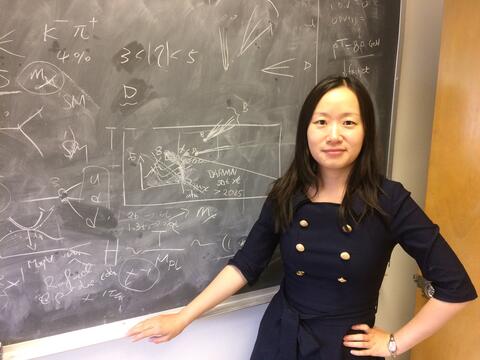Early in its history, shortly after the Big Bang, the universe was filled with equal amounts of matter and “antimatter” — particles that are matter counterparts but with opposite charge. But then, as space expanded, the universe cooled. Today’s universe is full of galaxies and stars which are made of matter. Where did the antimatter go, and how did matter come to dominate the universe? This cosmic origin of matter continues to puzzle scientists.
Physicists at the University of California, Riverside, and Tsinghua University in China have now opened a new pathway for probing the cosmic origin of matter by invoking the “cosmological collider.”
Not just any collider
High energy colliders, such as the Large Hadron Collider, have been built to produce very heavy subatomic elementary particles that may reveal new physics. But some new physics, such as that explaining dark matter and the origin of matter, can involve much heavier particles, requiring much higher energy than what a human-made collider can provide. It turns out the early cosmos could have served as such a super-collider.

Yanou Cui, an associate professor of physics and astronomy at UCR, explained that it is widely believed that cosmic inflation, an era when the universe expanded at an exponentially accelerating rate, preceded the Big Bang.
“Cosmic inflation provided a highly energetic environment, enabling the production of heavy new particles as well as their interactions,” Cui said. “The inflationary universe behaved just like a cosmological collider, except that the energy was up to 10 billion times larger than any human-made collider.”
According to Cui, microscopic structures created by energetic events during inflation got stretched as the universe expanded, resulting in regions of varying density in an otherwise homogeneous universe. Subsequently, these microscopic structures seeded the large-scale structure of our universe, manifested today as the distribution of galaxies across the sky. Cui explained that new subatomic particle physics may be revealed by studying the imprint of the cosmological collider in the cosmos’ contents today, such as galaxies and the cosmic microwave background.
Cui and Zhong-Zhi Xianyu, an assistant professor of physics at Tsinghua University, report in the journal Physical Review Letters that by applying the physics of the cosmological collider and using precision data for measuring the structure of our universe from upcoming experiments such as SPHEREx and 21 cm line tomography, the mystery of the cosmic origin of matter may be unraveled.
“The fact that our current-day universe is dominated by matter remains among the most perplexing, longstanding mysteries in modern physics,” Cui said. “A subtle imbalance or asymmetry between matter and antimatter in the early universe is required to achieve today’s matter dominance but cannot be realized within the known framework of fundamental physics.”
Leptogenesis to the rescue
Cui and Xianyu propose testing leptogenesis, a well-known mechanism that explains the origin of the baryon — visible gas and stars — asymmetry in our universe. Had the universe begun with equal amounts of matter and antimatter, they would have annihilated each other into photon radiation, leaving nothing. Since matter far exceeds antimatter today, asymmetry is required to explain the imbalance.
“Leptogenesis is among the most compelling mechanisms generating the matter-antimatter asymmetry,” Cui said. “It involves a new fundamental particle, the right-handed neutrino. It was long thought, however, that testing leptogenesis is next to impossible because the mass of the right-handed neutrino is typically many orders of magnitudes beyond the reach of the highest energy collider ever built, the Large Hadron Collider.”
The new work proposes to test leptogenesis by decoding the detailed statistical properties of the spatial distribution of objects in the cosmic structure observed today, reminiscent of the microscopic physics during cosmic inflation. The cosmological collider effect, the researchers argue, enables the production of the super-heavy right-handed neutrino during the inflationary epoch.
“Specifically, we demonstrate that essential conditions for the asymmetry generation, including the interactions and masses of the right-handed neutrino, which is the key player here, can leave distinctive fingerprints in the statistics of the spatial distribution of galaxies or cosmic microwave background and can be precisely measured,” Cui said. “The astrophysical observations anticipated in the coming years can potentially detect such signals and unravel the cosmic origin of matter.”
Cui was supported in the research by a grant from the U.S. Department of Energy.
The title of the paper is “Probing Leptogenesis with the Cosmological Collider.”
Header image credit: mik38/iStock/Getty Images Plus.
AUTHOR: IQBAL PITTALWALA